Distorted Memories and New Threats to the Realm
Hybrid fantasy on a Jingū votive tablet
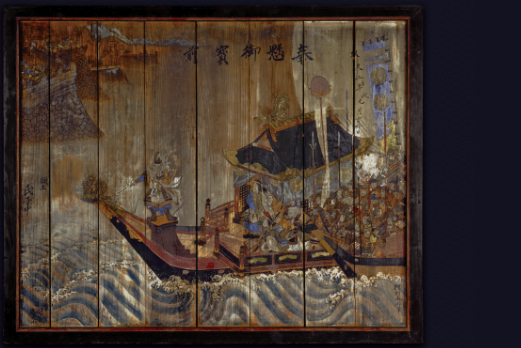 Kano Asanobu, Empress Jingū Shrine Plaque (Ema), 1862. Paint on wood tablet. 52 × 66 inches. Museum of International Folk Art, gift of Lloyd E. Cotsen and the Neutrogena Corporation, A.1995.93.1525
Kano Asanobu, Empress Jingū Shrine Plaque (Ema), 1862. Paint on wood tablet. 52 × 66 inches. Museum of International Folk Art, gift of Lloyd E. Cotsen and the Neutrogena Corporation, A.1995.93.1525
By Elizabeth Lillehoj
A colorful painting on a wooden tablet in the Museum of International Folk Art features the Japanese legend of Empress Jingū. Painted in 1862, the Jingū votive tablet looks back to Japan’s premodern interactions with its neighbor, Korea. But the painting has little to do with facts; instead, it presents distorted memories of ancient events and reactions to threats facing Japan in the nineteenth century.
Images of Empress Jingū appear on shrine tablets, painted scrolls, woodblock prints, and a variety of other media. Playwrights integrated Jingū tales into noh, kabuki, and puppet theaters. Authors incorporated Jingū into mythico-historical chronicles, narratives about religious institutions, local gazetteers, and war tales. Musicians wrote court songs about her.
The tablet at MOIFA is only one of many interpretations of the mythological empress, though the Santa Fe museum’s depiction includes many unique aspects that warrant further study. While not currently on view to the public, here El Palacio allows for exploration in great detail.
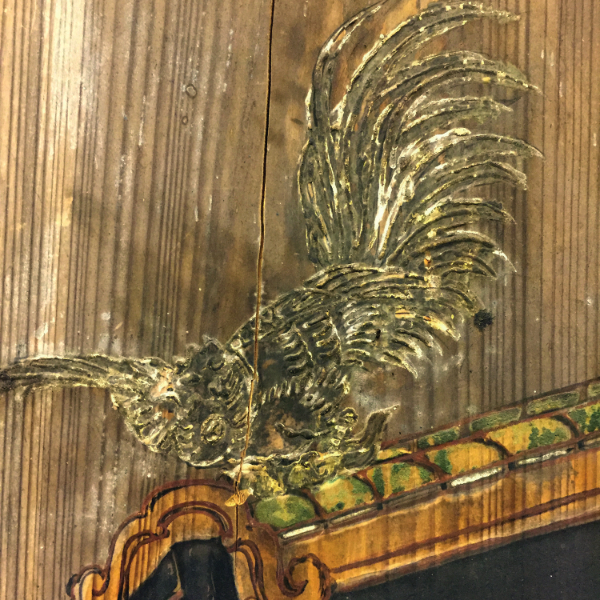

Shrine Tablets
The MOIFA Jingū votive tablet is a large ema, a type of painting meant for viewing by groups of visitors at a Shinto shrine. “Ema” means “painted horse(s).” The term derives from an early practice of dedicating live horses to shrines. Worshippers honored horses, said to carry messages to the gods and provide transportation for divine beings. Painted representations eventually replaced the live horses, and new subjects appeared on tablets.
Shrines display large-scale tablets outdoors under the eaves of sanctuaries or in open-air structures. Artists began using bolder colors and designs. They also enlarged the tablets’ size, allowing viewers who stood below to identify subjects from a distance. Over time, as a result of exposure to humidity and sunlight, the tablet surfaces weathered and darkened.
Inscriptions
Across the top of the Jingū votive tablet is a boldly written inscription, which is read from right to left as “Hung and respectfully dedicated to the gods” (Hōken gohōzen). At the left side of the tablet is another inscription, explaining that two male members of a religious congregation commissioned the piece for dedication to a Shinto shrine. The name of the shrine is unknown, but the two men likely lived and worshipped at the shrine where they donated the work.
Of the two additional inscriptions on the tablet, one gives the date of 1862 and the other tells the artist’s name: Kano Asanobu. Many painters used the surname Kano, and several achieved renown as talented artists. It is unclear whether Asanobu was a lineal descendent of the influential Kano family. More likely, he adopted the name after training in a Kano workshop and then worked in a provincial atelier, perhaps as a specialist in painting shrine tablets.
The Figure of Jingū
Asanobu portrayed mythic Empress Jingū in a boat near the center of the tablet. She sits alongside a cohort of gods and soldiers, staring at cliffs along the Korean shoreline. Having recently arrived from her homeland on the Japanese archipelago, Jingū is preparing to disembark and conquer the Three Kingdoms—Shiragi (Korean: Silla), Kudara (Baekje), and Kōkuri (Goguryeo)—which controlled most of the Korean peninsula in the first centuries CE. Myths claim there was a queen-regent named Jingū at the time, but most historians have concluded that Jingū never existed (or, at most, that she was semi-historical).
Asanobu portrayed Jingū as a grand and imposing presence. The legendary queen-regent functions as commander-in-chief of her fleet. She sits at the edge of a cabin on the leading ship. A gilded sculpture of a phoenix, a symbol for virtuous imperial reign, perches with outstretched wings atop the cabin roof directly over her.
Although pigment that Asanobu applied to Jingū’s face has flaked away, we can make out her features sketched in under painting. Asanobu represented Jingū in armor with a sheathed sword. Her hair is held in place with a white headband in preparation for battle, and she holds on her lap a tall war fan.
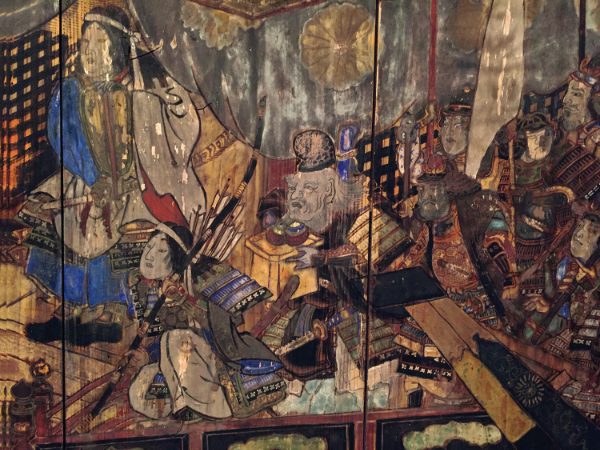
Origin of the Jingū Legend
Asanobu followed the oldest known written descriptions of Jingū’s legendary incursion onto the Korean peninsula. The descriptions appear in two accounts: the Records of Ancient Matters (Kojiki, dated 711–12) and the Chronicles of Japan (Nihon shoki, 720). These official mythico-histories of Japan identify Jingū as the wife of second-century Emperor Chūai and as a sorceress who channels the voices of the gods. According to the accounts, Jingū fulfills a divine mission given to Chūai before his death to lead forces across the sea and assume control of the peninsula. Jingū manages this without bloodshed and, upon returning home, she gives birth to Chūai’s son, later known as Emperor Ōjin.
The veracity of the early accounts is dubious, as they were composed long after the purported lifetime of Jingū and under imperial auspices as part of a project to justify Yamato rule. The accounts were compiled by a group of courtiers instructed to narrate the alleged divine origin and unbroken lineage of the ruling Yamato dynasty. The dynasty had emerged in the fourth century as a federation located in what is today central Japan, including Nara and Kyoto. By 700—shortly before the two mythico-historical accounts were composed—Yamato emperors had unified the heartland of the archipelago.
A key reason it has been impossible to confirm claims about Jingū’s existence is the paucity of records on early Japan, then mostly non-literate. Yet, the oldest known written source on prehistoric Japan, a Chinese account of about 297 entitled “Treatise on the People of Wa,” mentions a female ruler named Himiko who ended a civil war in the second century and ruled Yamatai on the archipelago.
Early Yamato leaders seem to have borrowed the description of Himiko from “Treatise on the People of Wa” and used it to advance their quest for legitimacy. They claimed that “Treatise on the People of Wa” confirmed the Yamato emperor’s right to rule given that the imperial line descended directly from Himiko.
The memory of Himiko possibly spawned the Jingū legend; indeed, authors of medieval and early modern Japan commonly held that Jingū was Himiko. Officially speaking, however, Jingū is mythological. Her name was excised from the list of Japanese emperors, and she is deemed legendary. Today, historians point out that many aspects of the Jingū legend appear to have been invented, even the name “Jingū” (meaning “divine success”).
That said, certain elements of the Jingū legend might have been based loosely on historical realities. It is known, for example, that peoples in East Asia had long interacted, even before either Korea or Japan came to be governed by a single unified regime. Several premodern kingdoms on the peninsula and the archipelago struggled between one another, locally and across the sea. More common than armed conflicts, however, were extended periods of open exchange.
For centuries on end, the two East Asian neighbors engaged in peaceful interaction, making the scene of battle captured on the Jingū votive tablet an anomaly. In fact, many ancestral links connected peoples of the peninsula and the archipelago. It is estimated, for example, that a third of aristocratic Japanese in the eighth century could trace their ancestry to Korea, their relatives having moved to the archipelago during the previous five hundred years.
One of Jingū’s own forefathers is said to have been a Shiragi prince who immigrated to Japan from the Korean peninsula. This Shiragi ancestor carried to Japan ritual objects associated with religious authority. According to early accounts, the Japanese emperor ultimately acquired the imported objects, providing Yamato leaders a special link with the peninsula’s advanced culture.
Jingū’s Companions
In the queen-regent’s crew on the tablet, there are several gods. One is the Great God Sumiyoshi, shown kneeling to the right of Jingū. Sumiyoshi appears as an elderly aristocratic gentleman with a black courtier’s cap and wispy white hair, beard, and eyebrows. He holds up a short stand atop which sit two magical orbs—the tide-ebbing and tide-raising jewels. Medieval versions of the legend claim Sumiyoshi had informed Jingū of the orbs’ power, and the empress had sent him to the palace of the Dragon King at the bottom of the sea to procure the jewels. Jingū succeeds in her mission due to the jewels. Joining Sumiyoshi on the quest was Jingū’s sister, Toyohime. In the votive tablet, Toyohime sits between Sumiyoshi and the queen-regent.
Japanese samurai appear in a second boat, slightly to the right of Jingū’s vessel. The samurai wear distinctive armor of lamellar construction with small rectangular plates laced together in horizontal rows, creating flexible protection. Several warriors wear ornate chest plates. Their helmets have a short visor and a segmented neck guard extending out at the back. The Japanese weapons they hold include the long bow, the spear ending in a curved naginata blade, the trident-headed spear, and the yari spear with a single straight blade.
Banners and other heraldry in the votive tablet are recognizable from early Japanese battle scenes. Perched on wafting clouds atop one banner is a large red disk. This solar motif refers to the Sun Goddess and to the land of the rising sun, Japan.
Although the Jingū legend can be traced back to the eighth century, it evolved over time, especially during Japan’s medieval period from the thirteenth through the sixteenth centuries. Medieval authors affiliated with shrines and temples along Japan’s southern seacoast worked to promote their cultic centers by re-writing the Jingū legend and by adding the names of formerly obscure gods. One such god was Isora.
Isora is identified as the progenitor of the Azumi people, who were linked to the Yamato aristocracy and who led maritime ventures. Jingū allegedly set sail for the Korean peninsula from a religious site worshipping Isora. The site is located at Shikanoshima on Kyushu, Japan’s southern island. Shikanoshima long served as a landing point of ships sailing between Japan and continental East Asia.
In the votive tablet, Isora stands on a raised platform near the bow of Jingū’s boat. Leading the empress’s retinue forward, the sea god wears Japanese armor and has two sheathed swords tucked under his belt. As he confronts Jingū’s opponents, Isora waves two sacred wands with white paper strips meant to ward off evil. Thanks to Isora’s use of the magic wands, enemy arrows fall away into the sea.
Early descriptions of Isora say he is hideous in appearance with barnacles and shells covering his face, but the artist of the tablet depicted no encrustations on Isora. Instead, Asanobu presented Isora as an impressive man with flowing white hair and a deep frown. The creases in Isora’s forehead suggest his intense absorption in warding off the enemy. The god wears a court cap with a knob at back from which a long tail extends. Originally donned by Japanese noblemen for formal events, this type of cap was later adopted by Shinto priests.
The Death of Emperor Chūai
Of the medieval alterations to the Jingū legend, perhaps most fanciful is the embellishing of Chūai’s death. According to one medieval tale, an eight-headed Korean demon killed Jingū’s husband during the attack on Japan. This fantastical tale appears in the fourteenth-century text Lessons on Hachiman for Ignorant Children. Priests of Iwashimizu Hachiman Shrine, associated with the imperial court, likely composed Lessons on Hachiman, intending to promote their shrine by describing its mystical origins. This version of the Jingū legend has novel references to repeated foreign attempts to invade Japan, all of which fail due to the intercession of divine beings. By claiming that Chūai was a victim of Korean aggression, the medieval Lessons on Hachiman positions Jingū’s campaign as a response to foreign invasion. In addition, it recasts the Jingū story in Buddhist terms and transforms Jingū into a savior being.
Attempted Mongol Invasions
Shikanoshima, one of the main sites of Isora worship, served as a memorable battleground in 1274 and 1281, when Japanese warriors twice defended the realm against Mongol-led invaders. In 1274, Japanese warriors faced a massive enemy force—a joint Mongol-Korean-Jurchen-Han Chinese coalition—arriving by sea at Hakata Bay in northern Kyushu. Defenders routed the attackers, who fled. Seven years later, a significantly larger Mongol-led fleet appeared. It was met by violent winds off the Kyushu coast and invaders were again forced to flee.
As Japanese storytellers narrated accounts of the Mongol invasions, they added fantastical elements to explain how Japan managed to fend off the aggressors. According to one new narrative, a green dragon lifted its head from the waves to wreak havoc on foreign ships. It was said Japan’s victory owed to divine intervention as the emperor had prayed to the Sun Goddess, beseeching her to protect the realm.
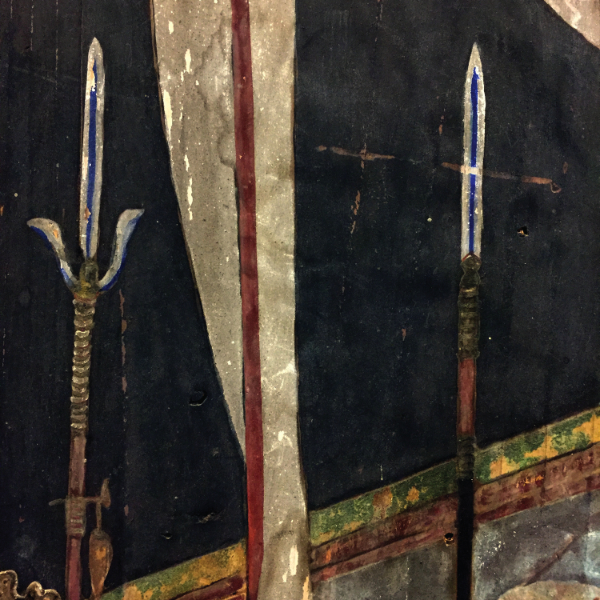
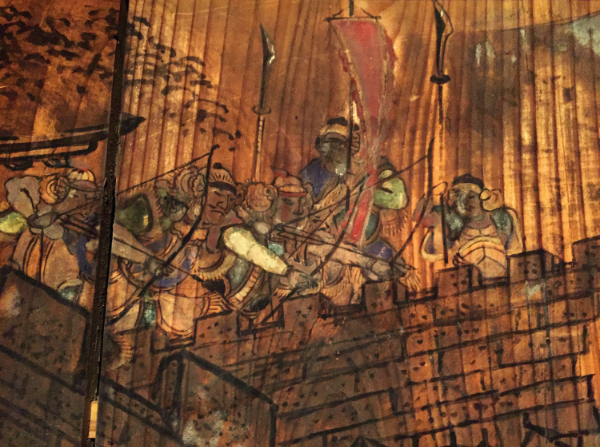
Soon after the Mongol-led attacks, Japanese authors began conflating the recent defense of the realm with Jingū’s legendary Korean campaign. Even though the Mongol invasions occurred long after Jingū’s alleged lifetime, the correspondence with her campaign was considered valid. But the correspondence was clearly arbitrary, a kind of psychological compensation for the trauma of the Mongol assaults, in which foreigners managed to approach and attack Japan.
Certain details in the votive tablet owe to the medieval conflation of Mongol invasions and Jingū lore. Most notably, defenders atop the sloping stone ramparts at left are depicted with weapons, costumes, and heraldry identifying them as Mongol-led soldiers of the thirteenth century, not Koreans from much earlier times. The soldiers wear Mongol helmets with protective flaps that curl outward over their ears and embellishments of fur and feathers. Several defenders hold a type of Mongol pole weapon with a short curving blade known as a moon blade. Others shoot distinctive short bows and rain down arrows from on high. Here, the artist captured the notorious Mongol tactic of shooting arrows en masse into the air. The defending ranks display a type of long red banner, unlike the blue and white banners and sun disk emblem of Japanese heraldry.
Modern Jingū Images
In 1862, when Asanobu painted the tablet, Jingū images proliferated in Japan. Most featured fantastical elements added to the Jingū legend in the medieval period. Jingū was further altered in the modern era to serve as a potent martial symbol for a country facing unprecedented change.
In 1839, war had broken out between China and Britain. Chinese authorities resisted Britain’s imposition of the opium trade, but China lost the war. After a second defeat several years later, China submitted to Britain’s demands and opened treaty ports to European commerce. Japanese audiences watched developments on the continent, recognizing the vulnerability of their own country. If Westerners could demand free entry, extraterritorial rights, and trading privileges from China, they could easily demand the same from Japan.
A debate swept across Japan over how to avoid foreign domination. Leaders began to ramp up border defenses to combat the threat of Western colonialist incursions. But it became clear in 1853—when U.S. Admiral Matthew Perry arrived in Tokyo Bay with a squadron of four black ships—that Japanese authorities could not control the encroachment of unwelcome Western vessels into Japanese territorial waters. The government acceded to U.S. demands, and Japan opened its doors to foreign trade.
During the Meiji period, which began in 1868, nationalistic sentiments increased. Distorted memories of Japan’s past achievements in Korea were promoted in the form of freshly minted Meiji versions of medieval tales. Japan, meanwhile, was implementing expansionist policies of its own and soon emerged onto the world stage as a colonialist and imperialist power. Meiji authorities argued among themselves over when to invade Joseon Korea. After nearly a half-century of debate, authorities took action in 1905 and annexed the peninsula. Then for four decades, Japan dominated Korea.
Throughout the early years of the twentieth century, representations of the Jingū legend trumpeted Japan’s military successes of the past, portraying the queen-regent as a heroic role model for modern Japan. Jingū imagery remained current during WWII, when the Jingū conquest story was integrated into textbooks read nationwide in Japanese elementary schools. As full-blown propaganda, it was meant to justify the unfortunate Japanese aggression toward and colonization of Korea.
But shrine visitors who had viewed the votive tablet in 1862—before Japan’s modern invasion of Korea, when the tablet was first installed as an ema—could have appreciated the martial, monarchial, and sacred features of the image. They would have understood that this and many other contemporary paintings of the legendary empress showed Jingū as a heroic role model for the modern nation. Moreover, viewers likely knew that the tablet scene was highly inaccurate in historical terms; it was not a documentary portrayal of actual events from the past. The artist had presented the Jingū story as a hybrid fantasy, addressing a growing anxiety in Japan about threats to the country’s sovereignty.
—
Elizabeth Lillehoj is a research associate of the Museum of International Folk Art and a professor emeritus of Asian art history at DePaul University, Chicago. Her research focus is premodern Japanese art. Her 2011 book, Art and Palace Politics in Japan, 1580s–1680s, appears in Brill’s Japanese Visual Culture series.




